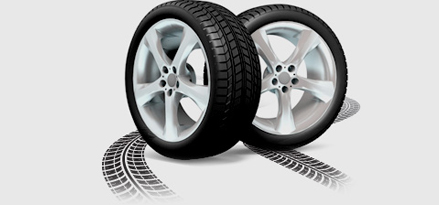Four for fighting
What's a driver's best performance asset? Why it's the four round things at each corner of the car.
The single most important factor in vehicle performance, and we're not even talking about high-performance yet, is the humble tyre.
Think about it - these rubber rings are the only contact our vehicle has with the ground. If your tyres are shot, you simply have no grip. Tyres are also an integral part of the suspension system, by providing a flexible cushion that absorbs shock.
For those reasons, tyre safety is a hugely important issue: Take care of your rubbers and they'll take care of you. Here are some tyre safety tips to help you take care of your tyres the right way.
It's a good idea to check your tyres at least once a week. It's an easy, five-minute job. Simply check your tyre wear indicator (look at your manufacturer's website for more info), do a visual once-over of the tread and body, and use a tyre pressure gauge to make sure they're properly inflated.All this will ensure tyre longevity, improve grip and fuel efficiency. A tyre under-inflated by just 1psi can increase fuel consumption by as much as 3%.
Just like cars, there are different kinds of tyre, each with different strengths and aims. Common categories of tyre include high-performance, touring, budget and eco-friendly types. What do you pay for in a tyre? The compound, which is what the black stuff itself is, might look the same but actually varies widely. Top makers put in their own secret additives to maximise performance - silica, carbon black and various kinds of oils.
The single most important factor in vehicle performance, and we're not even talking about high-performance yet, is the humble tyre.
Think about it - these rubber rings are the only contact our vehicle has with the ground. If your tyres are shot, you simply have no grip. Tyres are also an integral part of the suspension system, by providing a flexible cushion that absorbs shock.
For those reasons, tyre safety is a hugely important issue: Take care of your rubbers and they'll take care of you. Here are some tyre safety tips to help you take care of your tyres the right way.
It's a good idea to check your tyres at least once a week. It's an easy, five-minute job. Simply check your tyre wear indicator (look at your manufacturer's website for more info), do a visual once-over of the tread and body, and use a tyre pressure gauge to make sure they're properly inflated.All this will ensure tyre longevity, improve grip and fuel efficiency. A tyre under-inflated by just 1psi can increase fuel consumption by as much as 3%.
Just like cars, there are different kinds of tyre, each with different strengths and aims. Common categories of tyre include high-performance, touring, budget and eco-friendly types. What do you pay for in a tyre? The compound, which is what the black stuff itself is, might look the same but actually varies widely. Top makers put in their own secret additives to maximise performance - silica, carbon black and various kinds of oils.

Tread pattern, which is the jumble of squares and triangles, is the other main difference. Some are biased toward quietness and lower rolling resistance, while others maximise grip. Rain grooves, a design element of the tread pattern, also dictate how a tyre will perform in wet conditions.
The other factor in this equation is wheels. Wheels, or rims as they're commonly known, are what the tyres are mounted on.
Tyre choice is down to the characteristics of your vehicle's wheel size, which refers not only to diameter but width as well.
Wheels can also contribute to performance. Factory rims usually weigh more than their aftermarket counterparts because of their price, construction and material choice. After-market wheel upgrades are popular because they offer a different look and may improve performance. Larger wheels offer better clearance for brake upgrades, while there may be more grip since the contact patch is larger - that is, they put more rubber into direct contact with the tarmac. Bear in mind though that upsizing your rims may also adversely affect fuel efficiency and increase weight instead of reducing it. Suspension and steering could also be adversely affected if getting the sizes wrong puts your car's suspension geometry out of spec. Ultimately it's best to stick to sizes recommended by your manufacturer, but within those there is plenty of scope to choose stickier tyres that offer more grip and lighter, snazzier-looking rims.
This article is written by Leow Julen, contributing writer for Top Gear Singapore, and Samuel Kang, editor for Rev magazine.
Tyre choice is down to the characteristics of your vehicle's wheel size, which refers not only to diameter but width as well.
Wheels can also contribute to performance. Factory rims usually weigh more than their aftermarket counterparts because of their price, construction and material choice. After-market wheel upgrades are popular because they offer a different look and may improve performance. Larger wheels offer better clearance for brake upgrades, while there may be more grip since the contact patch is larger - that is, they put more rubber into direct contact with the tarmac. Bear in mind though that upsizing your rims may also adversely affect fuel efficiency and increase weight instead of reducing it. Suspension and steering could also be adversely affected if getting the sizes wrong puts your car's suspension geometry out of spec. Ultimately it's best to stick to sizes recommended by your manufacturer, but within those there is plenty of scope to choose stickier tyres that offer more grip and lighter, snazzier-looking rims.
This article is written by Leow Julen, contributing writer for Top Gear Singapore, and Samuel Kang, editor for Rev magazine.
